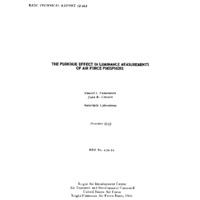-
Title
-
The Purkinje Effect In Luminance Measurements Of Air Force Phosphors
-
Date
-
1952
-
Index Abstract
-
Coming Soon
-
Photo Quality
-
Complete
-
Report Number
-
WADC TR 52-282
-
Creator
-
Pomerantz, Daniel I.
-
Cannon, John R.
-
Corporate Author
-
Materials Laboratory
-
Laboratory
-
Materials Laboratory
-
Extent
-
29
-
NTRL Accession Number
-
AD005353
-
Identifier
-
AD0005353
-
AD Number
-
5353
-
Access Rights
-
Notice(s)
-
Distribution Classification
-
1
-
Contract
-
None Given
-
DoD Project
-
None Given
-
DoD Task
-
None Given
-
DTIC Record Exists
-
Yes
-
Distribution Change Authority Correspondence
-
AFAL ltr
-
Distribution Change Action Date
-
9/16/2002
-
Abstract
-
A formula is derived for relating effective and photopic units of luminance by means of Weaver's interpolated data (J. Opt. Soc. Amer. 39:281, 1949) for the mesopic luminosity functions. The formula is applied to the spectra of 4 typical AF luminescent phosphors; results are compared with experimental data. Individual values of B'/B reveal considerable dispersion around the mean value, particularly as the match becomes more heterochromatic; B' is the specified luminance measured in effective units of luminance, and B is the luminance of the same area in photopic lamberts. Averaged values agree with the B'/B curves. Weaver's data is tentatively accepted for conversion between effective and photopic units in luminance measurements of luminescent materials. A study of the effect of color on the results of the Purkinje effect showed that colors furthest removed from that of the standard 2360 deg K source exhibited the most pronounced change in B'/B with decreasing luminance. The blue phosphor produced over 4 times as much visual response per unit energy at the lowest luminances than at luminances above 1 ft-lambert; the red phosphor produced about 1/5 the amount.
-
Report Availability
-
Full text available
-
Date Issued
-
1952-10
-
Provenance
-
IIT
-
Type
-
report
-
Format
-
1 online resource
 WADCTR52-282.pdf
WADCTR52-282.pdf